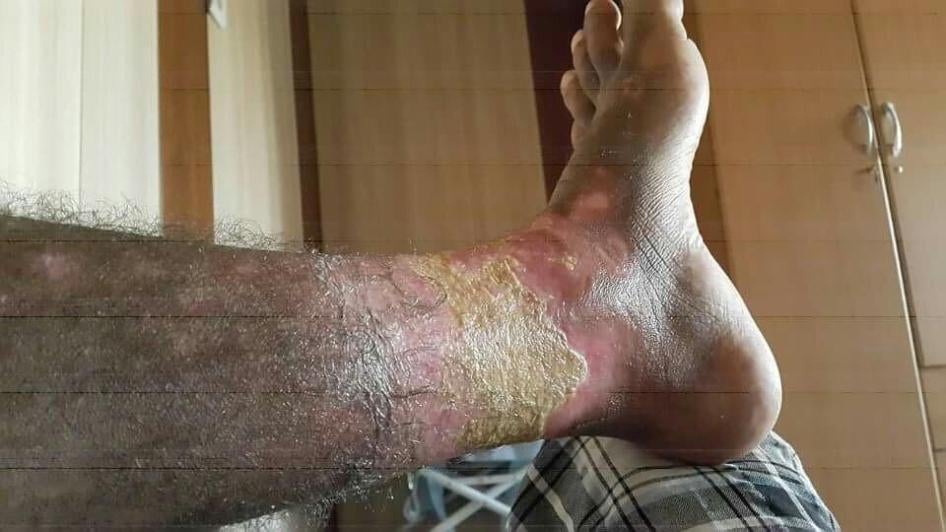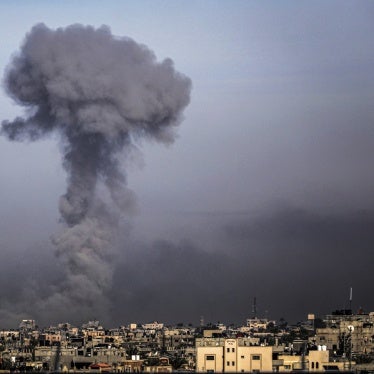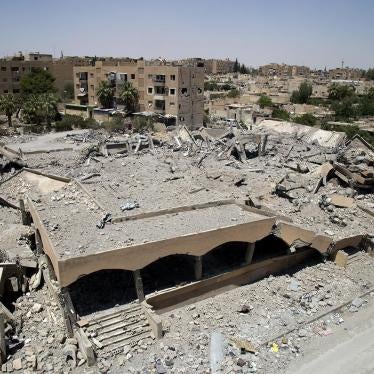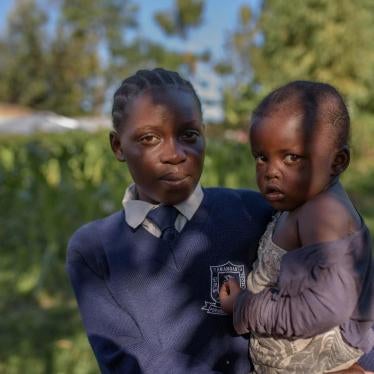(Erbil) – Forces of the Islamic State (also known as ISIS) launched at least three chemical attacks on the Iraqi town of Qayyarah. The use of toxic chemicals as a means of warfare is a serious threat to civilians and combatants in and around the embattled city of Mosul and is a war crime.
The attacks hit the town of Qayyarah, 60 kilometers south of Mosul, in September and October after Iraqi government forces retook the town on August 25, 2016. The attacks caused painful burns to at least seven people consistent with exposure to low levels of a chemical warfare agent known as “vesicants,” or blister agents, a chemical weapons expert told Human Rights Watch.
“ISIS attacks using toxic chemicals show a brutal disregard for human life and the laws of war,” said Lama Fakih, deputy Middle East director. “As ISIS fighters flee, they have been repeatedly attacking and endangering the civilians they left behind, increasing concerns for residents of Mosul and other contested areas.”
Iraqi and Kudistan Regional Government forces, supported by a United States-led coalition, have been moving up the Tigris River, retaking towns and villages from ISIS. The Qayyarah attacks preceded the military operations that began on October 17 to retake Mosul, Iraq’s second-largest city.
At the time of the attacks, ISIS forces were holding positions between three and six kilometers north of the town. Fifteen Qayyarah residents told Human Rights Watch on October 31 that these were the first attacks of their kind in the area. They, as well as a staff member at the US embassy in Baghdad, said ISIS carried out the attacks. The residents based this on the fact that Iraqi forces were fully in control of the town of Qayyarah at the time, with ISIS carrying out attacks on the city, targeting military positions. They believed that ISIS was trying to force the town’s population to flee toward them, based on reports that ISIS had tried to compel civilians to retreat with them in other areas, then target opposing forces entering the area. Human Rights Watch could not confirm this allegation.
Media outlets reported that on September 20, ISIS launched projectiles containing chemicals to attack the Qayyarah West airbase, which was captured by Iraqi and coalition forces in July. Coalition spokespersons tweeted after that attack that laboratory testing had found “no Mustard Agent present” on the munitions fired at the airbase. But Qayyarish residents described to Human Rights Watch three attacks that caused injuries consistent with the use of chemical warfare agents.
In the first attack in Qayyarah itself, on September 21, a projectile landed in a family’s garden, oozing a liquid that caused burns and blistering to two family members and two policemen who helped them remove it.
In an attack on October 6, a projectile struck in front of a café, near a motorbike that belonged to two fighters. The fighters rode away on their motorbike, but developed severe burns where the bike came in contact with their skin. Doctors first thought the injuries were caused by chlorine, but later determined they were caused by a blister agent. On October 10, a projectile landed in front of a refinery, and a worker who rode away on a motorbike that had been nearby developed similar burns and blistering.
An independent expert on the detection and effects of chemical warfare agents, Keith B. Ward, reviewed the video and photo evidence and accounts of those harmed in the attacks. He concluded that the characteristic “garlic” odor and the burning of the eyes, which one man described right after the attack in his garden; the subsequent reddening of the skin; and the delayed appearance of blisters on the skin of the seven injured men are consistent with exposure to low levels of a chemical warfare agent of the type known as “vesicants,” or blister agents. Sulfur Mustard is a common type of blister agent and some pure or degraded form of this agent may have been present in the projectiles used in the three attacks investigated, Ward said. Victims could have been exposed to this agent directly at the time of the attack or by later contact with nearby objects contaminated with the blister agent. A more definitive identification of chemicals used in these attacks would require the analyses of soil and water samples collected by specialized teams near the attack sites and of tissue samples collected from the victims.
The initial skin burns as well as the blisters that usually follow within a day have been described as excruciatingly painful by those exposed to blister agents Ward said. In addition to these immediate effects, exposure to blister agents can have more long-term consequences. These include an increased occurrence of cancers of the respirarory system, chronic conjunctivitis, and several chronic skin conditions such as skin ulceration, scar formation, and cutaneous cancers.
Three members of a family living just off the main road running through Qayyarah told Human Rights Watch that at about noon on September 21, a projectile landed in their garden. It left a crater of about 2-by-2 meters, and a thick yellowish liquid oozed out that turned the garden soil black and yellow, accompanied by a strong odor. One of the sons, a student in his early 20s, said that once a local police arrived, he and his cousin helped two of them pull the projectile out of the ground:
While we were trying to get it out, my eyes started burning. There was a strong smell of something like garlic or rotten onions. We sprayed water on the [projectile], and some of that water then got on our hands and legs. After three hours I felt a burning sensation and intense pain in my legs and arms and my skin started to get red. The next morning, blisters appeared on my leg.
Human Rights Watch researchers visited the strike site on October 31, and while there could smell the residual strong odor in the garden.
According to the son, the local health clinic sent him, his cousin, and the two policemen, who showed the same symptoms, to a hospital in Erbil. There doctors cleaned the burns and blisters and applied a cream containing sulfa, which is used to treat and prevent infections from second- and third-degree burns. He and his cousin said that they went home but the pain got worse so the next day they went to Tikrit and from there to Baghdad Medical City Hospital for treatment for several days. They did not know how the policemen fared.
Human Rights Watch researchers saw and photographed the mens’ burns, still evident more than a month later. One man was burned on his upper right wrist, and the other had several blisters on his lower left leg. They provided photos of the wounds to the arms and left leg of one of the policemen. They also gave videos of the approximately 2-meter rocket-assisted projectile that struck their garden and the puddle of yellowish liquid that came out of it, as well as of the police arriving and removing the projectile.
Café Attack, October 6, 2016
Four men working at a café along the main Qayyarah road said that on October 6, a projectile struck in front of the café, leaving a puddle of what the café owner described as greenish liquid. Later that day, the owner saw three men who local security forces told him were Americans in white hazmat suits, wearing gloves, masks, and carrying oxygen tanks on their backs inspecting the area. Then three uniformed policemen drove the expended rocket motor portion of the weapon to the banks of the Tigris River and dump it into the water. Human Rights Watch researchers went to the site where the rocket motor was deposited but were unable to see any remnants. They also reviewed photos of the team of three men in hazmat suits posted by residents on Facebook, which were consistent with the café owner’s description, and a video of the police dumping the remnant into the river.
Two fighters affiliated with a local tribal militia (Hashad al-Asha`ri) said that their motorbike was parked on the main road, a few meters away, when the projectile landed by the café and exploded. They didn’t realize the projectile might have been filled with chemicals, so they ran to the area and got on their bike to drive away. They described a strong smell and showed Human Rights Watch burns that they said resulted from their contact with their motorbike immediately after the incident. One still had burns on his entire right hand, with large discolored patches, from gripping the handle. The other had large burns down his inner thighs, from where his skin touched the bike cushion.
Two doctors at the Qayyarah Clinic told Human Rights Watch that they cleaned the two men’s wounds, thinking the attack was chlorine gas because of the strong smell, and sent them to a hospital in Erbil for further treatment. “The pain from the burns was so bad that I could barely breathe,” the fighter with wounds on his thigh said. “I could not sleep more than an hour before waking up from the pain.”
They said that doctors at a hospital in Erbil cleaned their wounds and sent them home. The next day, the men said large blisters appeared on the burned areas, and they returned to the Erbil hospital, at which point the doctors changed their diagnosis to a blister agent.
Refinery Attack, October 10, 2016
At around noon on October 10, a projectile struck just outside the Qayyarah petroleum refinery, a worker there told Human Rights Watch. He said he rushed out of the plant after the attack and got on his motorbike, which was parked a few meters from where the projectile landed, and drove home. He said that for three days, he could not walk because of painful burns that developed on his inner thighs. A local doctor called the hospital in Erbil that had treated the men wounded in the café attack and followed the doctor’s instructions based on the diagnosis of a chlorine attack.
The local doctor changed his diagnosis to a blistering agent based on the man’s clinical signs. A strong odor came from the basket on the bike that Human Rights Watch researchers could still smell on October 31, when they visited the strike site. They could faintly smell the same odor in the garden where the first projectile struck.
The refinery worker’s parents and sister said they had washed the clothes he had worn on the bike twice but the smell remained so they had to burn them. The refinery worker said he was the only one wounded by this third projectile, as far as he knew. He said that Iraqi soldiers were inside the refinery, using it as a temporary military base.












